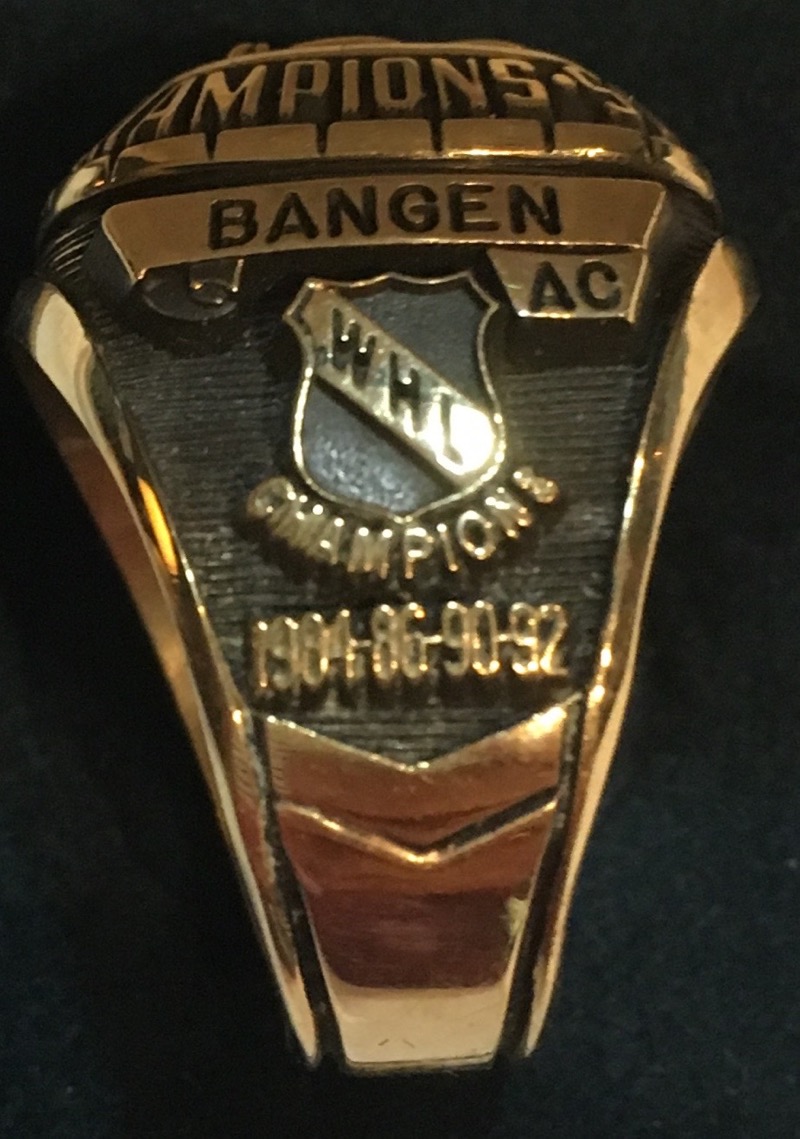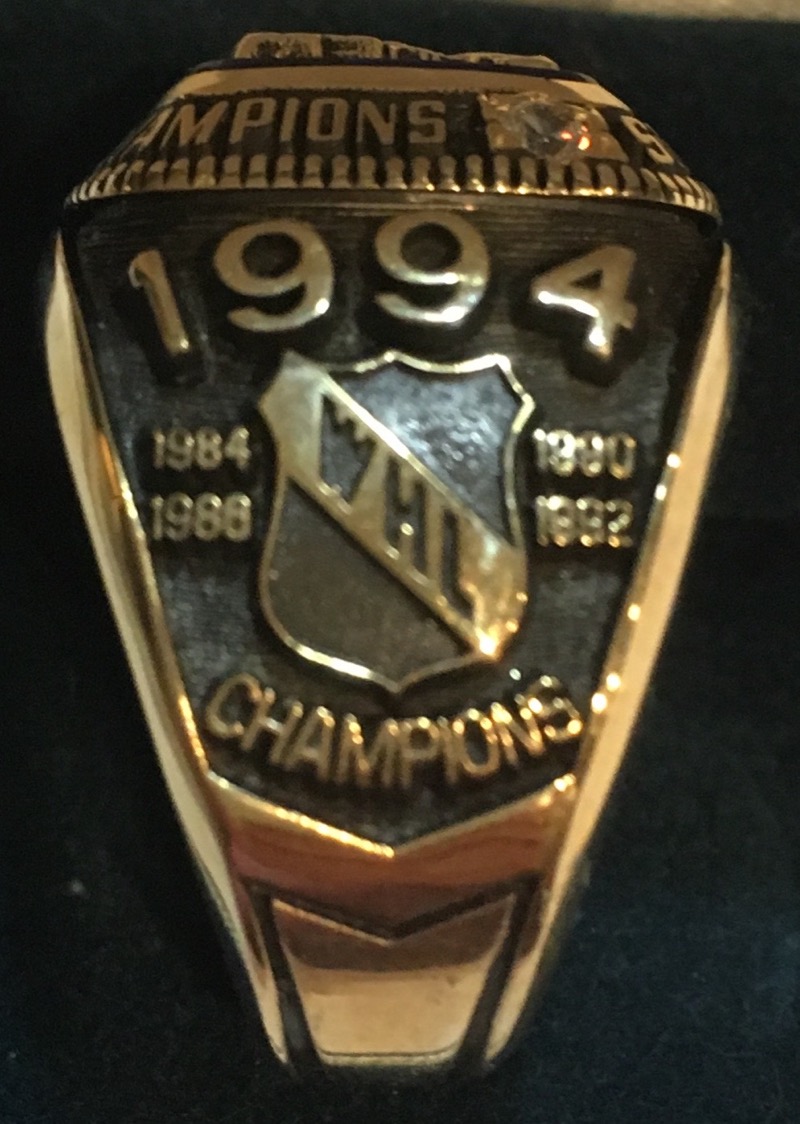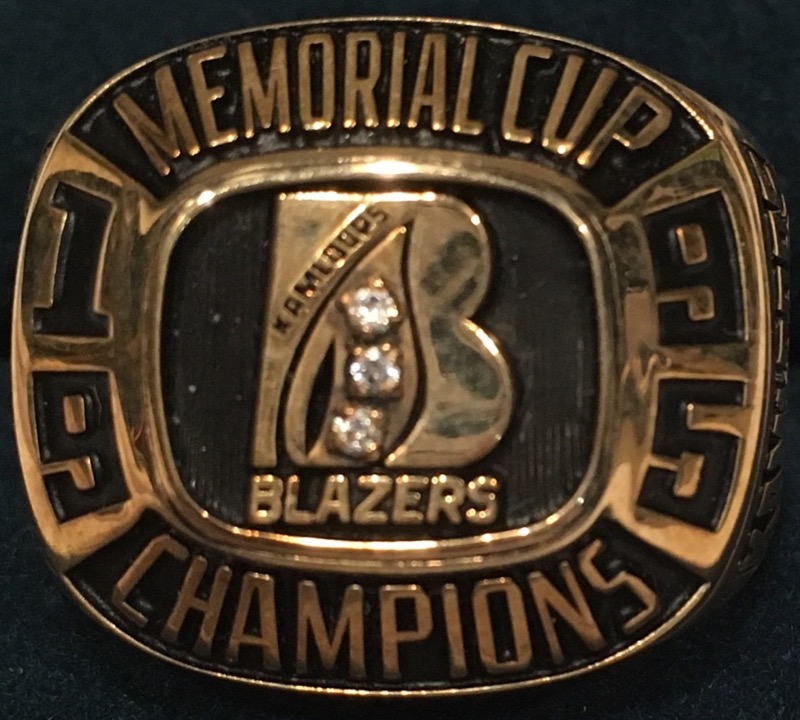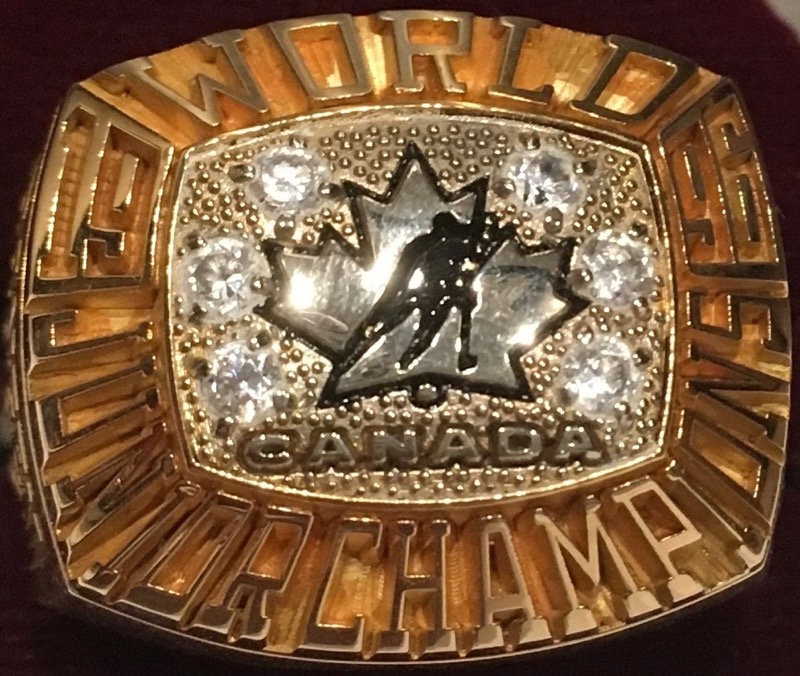WHAT’S IN A RING?
Who was the first local hockey player to wear a Stanley Cup ring? Was It:
Francis Donald – Charlie Turner - Pete Wright – Johnny MacMillan – Duke Edmundson- Darren McAusland, Carter Rowney or Stan Neufeld?
Any one of the above would be a good guess. I suspect many of our readers might have selected Carter Rowney since he was on the Pittsburgh Penguin roster last hockey season when they won the cup. He did not have possession of the coveted ring when he brought the Cup to Sexsmith in July. He has since received it but was he the first local player to wear a ring? (Under Stories see “SMALL TOWN TO BIG TIME, DUGOUTS TO FORUMS: THE STORY OF CARTER AND THE CUP”).

Carter Rowney and his Stanley Cup ring. Photo courtesy of Carter Rowney.
“The ring I have is a 1994 Calder Cup Championship ring that I won as a member of the Portland Pirates in the 1993/1994 season in the American Hockey League. We had a loaded team and were the minor league team for the Washington Capitals. I played about 61 games in the regular season but only a couple in the playoffs due to our team being so deep. I was 21 years old when we won. That team included Olaf Kolzig, Byron Dafoe, Sergei Gonchar, Jason Woolley, Jason Allison, Ken Klee, Andrew Brunette, Kevin Kaminski, Kerry Clark (Wendel's brother), Brian Curran..etc.. I was so young I didn't even appreciate the time enough but it was still a special thing to be a part of. We had a 20 year reunion back in 2014.” (Stan Neufeld Interview).

Darren McAusland and his Calder Cup ring from 1994. Stan Neufeld photo.
“Nope” is the answer to all of the above but we do have to go back a few years for the correct guess – 55 to be exact.
THE CORRECT ANSWER --------- JOHNNY MACMILLAN.
So - who is Johnny MacMillan? If you are familiar with GP Hockey Legends that have already been inducted you will know something about him. As a die-hard Leaf fan I have a special interest in him, the Leaf teams with whom he played and his story about the rings.
Johnny became a GP Hockey legend in 2005 in the Player category along with Marv Bird and my brother Bob Neufeld (Builder category).

Bob Neufeld, Marv Bird and Johnny MacMillan became GP Hockey Legends in 2005. Photo courtesy of Marv Bird.
Johnny was noted for his skating and puck handling ability. These skills were developed on outdoor rinks, Bear Creek and frozen sloughs that had to be scraped after every snowfall. (See website Legends link for Johnny in the player category). “I once competed against Johnny in a skating race at a winter carnival in Grande Prairie.” reported Bryan Edmundson, brother of the late GP Hockey Legend, Duke Edmundson. “He was the smoothest skater I ever saw.”
Following is Johnny’s story as recounted to Stan Neufeld during an interview in 2004.
“From 1942-1946 I played hockey on the post-War Legion team organized by Max Henning, Billy Bessent and other veterans who had returned home following WW11. We played mostly in the old Wapiti Arena along with numerous other teams coached by Legend Johnny Macdonald. I was a “rink rat” and I used to wear a sandwich board and walk the wooden sidewalks of Richmond Avenue in Grande Prairie to advertise games on a Saturday night along with Bob Rigler, Bruce Miller, and Gerald Chalmers while Don Patterson rang a cowbell. I received free admission to the senior games by keeping the scoreboard and then got to watch Pete Wright, Duke Edmundson, Ken Head, Bob Kelly, Chester Walden and Charlie Turner. I think it was in 1947 or 1948 that the Wapiti Arena roof caved in so we were without a covered ice surface. We skated on an open-air rink behind the Catholic school and we had fierce competition between Catholics and Protestants - wow! We would sometimes get my Dad to drive us to the local airport where we played in an old warehouse. Bear Creek was also a favourite place where we could skate for miles at night with a bon fire burning on the shore to provide light and warmth. In 1949-50 I played with the Army Cadets along with Bob Rigler, Donald Patterson, Mike Malarchuk, Bruce Miller, Victor Rigler and Bryan Edmundson. We were coached by RCMP officer, Frank Smith and Frank Edmundson.

Grande Prairie Army Cadets 1950
Back row from left: Frank Edmundson,coach, Leo Auger, Albert Cave, Donald Patterson, Roy Blais, C.J.Red Storey, Bruce Miller, Tom Leslie.
Front row from left: Wally Haakstad, Lawrence Blais, Johnny Listhaeghe, Don Miller, Bob Rigler, Vic Rigler, Johnny MacMillan, Eddy Klick, Brian Nelson. Missing Bryan Edmundson and Maurice Nicholson. Photo courtesy of the Rigler family.

Grande Prairie Legion 1950-51. Stan Neufeld photo collection.
Back row: Walt Hiekkila, Gordon Bond, Don Swanston, Harold Ayre, Deb Crough, John Lynn(mgr.) Robert Card, Charlie Turner, Ernie Nelson, Roy Wright, John Listhaeghe. Front row: Ron Neufeld, Bob Rigler, Johnny MacMillan, Fred Anderson, Lou Giroux, Jerry Moore, Kelly Schiekle.

Grande Prairie Red Devils 1951. Stan Neufeld photo collection.
In 1953 I left Grande Prairie to play for the Lethbridge Native Sons a team that competed in the old Western Canada Junior Hockey League. I played with them until 1956 and then went to the University of Denver to play for the U of D Pioneers, a team that was coached by the legendary Murray Armstrong. We had two championship teams during my time in Denver. In my final year, as Captain of the team we won the League Championship.” (Stan Neufeld interview with Johnny McMillan – 2004).
Johnny moved from Denver to become a member of the Leaf’s second dynasty as one of the original six NHL teams. As a young forward in 1960-61 Johnny scored three goals and was a solid contributor on a checking line with Bob Pulford and Ron Stewart. He started the next season in the AHL but was recalled half way through the schedule to serve as a utility forward. That spring MacMillan played three playoff games helping Toronto win its first of three straight Stanley Cups.

Toronto Maple Leafs, Stanley Cup champions, 1961-62. Johnny MacMillan is in back row far right.
During Johnny’s interview with Stan he shared some little known information about his Stanley Cup rings that harks back to the 1960s. The Leafs won four Stanley Cups in a span of six seasons, but rather than issuing a new ring to players every year they made changes to rings they already owned to acknowledge their participation. Only first-time championship players received rings. “When we won the Stanley Cup in 1962 I received a ring. When we won the cup again in 1963, they asked us to return our rings. We didn't know why. Later they returned the rings with the year engraved on the side and an enlarged diamond in the center. We had now won 2 Stanley Cups but had only one ring to show for it. Other NHL teams that had won multiple cups had a ring for each year! Needless to say everyone felt short changed.”

Toronto Maple Leafs, Stanley Cup champions, 1962-63. Johnny MacMillan is in back row second from right.

Johnny’s Stanley Cup ring with the Leafs. Photo courtesy of Johnny MacMillan.
The history of the ring dates back to 1893 – the first year of the Stanley Cup. I don’t know what the cost of producing a Stanley Cup ring was in 1893 but today the cost is $20.000.00 - $25,000.00. As it relates to Johnny - in the 1950’s a two-year contract and two rings represented a significant expense as the team winning the Stanley Cup had to build the cost of rings into their budget. That’s approximately $1 million. Whatever the cost of rings in Johnny’s era, team management determined to reduce their operating budget at the expense of the players. In the long run their decision did not pay off. They lost a substantial measure of good will from players that participated on more than one winning Stanley Cup team. In the final analysis it is to the Leaf’s credit that they eventually corrected a misguided decision. An interesting aside is that in 1971 the Montreal Canadiens gave players television sets instead of rings. Really? I wonder how the players on that team feel about that decision today? Is anyone willing to trade a Stanley Cup ring for a TV?
Following is another GP Hockey Legend trivia question:
Considering hockey players from Grande Prairie – who do you think has won the most rings?
I won’t belabour the point but will wager that it is GP Hockey Legend Terry Bangen. They are not Stanley Cup rings but Terry had a remarkable junior career with Kamloops Blazers, a team that won three Memorial Cup Championships when he was on the coaching staff along with Ken Hitchcock and Tom Renny. Terry earned a fourth ring as a member of the Team Canada coaching staff in 1996 when they won the World Junior Championship playing the final match against Sweden. As far as we know Terry is the most “be-jewelled” player coming out of Grande Priairie. Terry has and continues to make monumental contributions to the world of hockey that we intend to review in another context. He is presently Assistant Coach with the Worchester Railers of the ECHL. We are proud to claim Terry as a Grande Prairie product. He was inducted as a GP Hockey Legend under the Builder category in 2008.

Memorial Cup ring-1992

Memorial Cup ring-1994

Memorial Cup ring-1995

World Junior champions-1996
Photos courtesy of the Bangen family.
Stan Neufeld
Grande Prairie Hockey Legends is researched, written and presented by Stan and Ron Neufeld